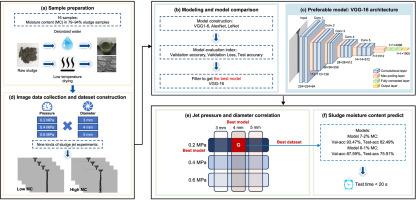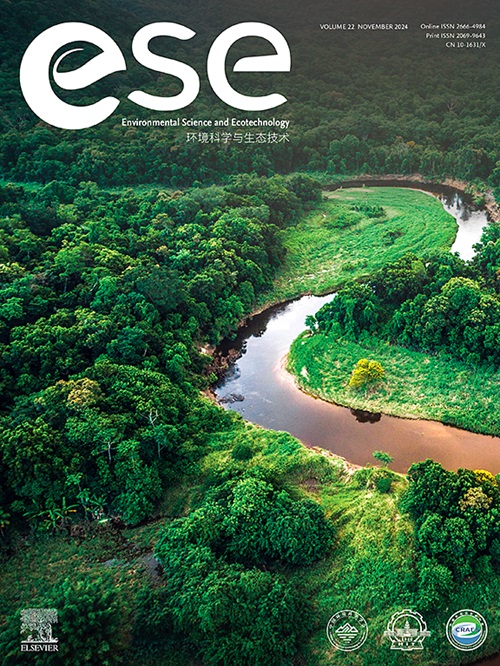通过喷射成像和深度学习实时监测污泥水分
IF 14.3
1区 环境科学与生态学
Q1 ENVIRONMENTAL SCIENCES
引用次数: 0
摘要
来自污水处理厂的废弃活性污泥对环境构成了重大挑战,其高水分含量使全球工业的处理和资源回收过程复杂化。有效的污泥管理需要精确的水分监测,以优化处理方法,降低成本,并提高厌氧消化和堆肥等结果。传统的水分测量方法耗时且基于批量,而新兴技术,如红外或核磁共振方法,在实时应用中存在不准确、高成本或限制。本研究表明,反映其非牛顿流体特性的污泥射流特性可以通过高速成像捕获,并通过深度学习进行分析,从而在20秒内准确预测水分含量。通过开发一个实验室规模的即时捕获活性污泥射流膨胀图像(iCASJEI)系统,我们在79 - 94%的湿度范围内获得了超过11,000张射流图像,并训练了卷积神经网络,vgg16在优化条件(0.2 MPa压力,4 mm孔径)下优于AlexNet和LeNet,在2%精度下达到93.5%的验证精度,在1%精度下达到87.6%。这些研究结果表明,将iCASJEI与深度学习算法结合,从污泥射流中提取非牛顿流体特性,可以大大减少污泥含水率的测试时间。这种方法也可以应用于其他领域,在这些领域中,非牛顿流体特性可以实时检测粘性液体中的水分。本文章由计算机程序翻译,如有差异,请以英文原文为准。

Real-time sludge moisture monitoring via jet imaging and deep learning
Waste activated sludge from wastewater treatment plants poses a major environmental challenge, with its high moisture content complicating disposal and resource recovery processes across global industries. Efficient sludge management requires precise moisture monitoring to optimize treatment methods, reduce costs, and enhance outcomes such as anaerobic digestion and composting. Traditional approaches for moisture measurement are time-intensive and batch-based, while emerging techniques, such as infrared or nuclear magnetic resonance methods, suffer from inaccuracies, high costs, or limitations in real-time applications. Here we show that sludge jet characteristics, reflecting its non-Newtonian fluid properties, can be captured via high-speed imaging and analyzed with deep learning to accurately predict moisture content within 20 s. By developing a laboratory-scale system of instantaneous capturing of activated sludge jet expansion images (iCASJEI), we acquired over 11,000 jet images across 79–94 % moisture ranges and trained convolutional neural networks, with VGG-16 outperforming AlexNet and LeNet under optimized conditions (0.2 MPa pressure, 4 mm aperture), achieving 93.5 % validation accuracy at 2 % precision and 87.6 % at 1 % precision. These findings show that incorporating iCASJEI to extract non-Newtonian fluid characteristics from sludge jets with deep learning algorithms can substantially reduce testing time for sludge moisture content. This approach could also be applicable to other sectors where non-Newtonian fluid characteristics enable real-time moisture detection in viscous liquids.
求助全文
通过发布文献求助,成功后即可免费获取论文全文。
去求助
来源期刊

Environmental Science and Ecotechnology
Multiple-
CiteScore
20.40
自引率
6.30%
发文量
11
审稿时长
18 days
期刊介绍:
Environmental Science & Ecotechnology (ESE) is an international, open-access journal publishing original research in environmental science, engineering, ecotechnology, and related fields. Authors publishing in ESE can immediately, permanently, and freely share their work. They have license options and retain copyright. Published by Elsevier, ESE is co-organized by the Chinese Society for Environmental Sciences, Harbin Institute of Technology, and the Chinese Research Academy of Environmental Sciences, under the supervision of the China Association for Science and Technology.
 求助内容:
求助内容: 应助结果提醒方式:
应助结果提醒方式:


